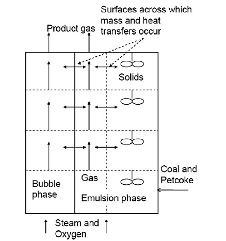Energy: Production and efficient utilization
Every engineering and industrial sector produces products that are used by the common man on a day to day life. The chemical industries are broadly divided into oil and gas, petroleum and petrochemicals, polymers, dyes, food and pharmaceuticals, rubber and plastics, fertilizers, metallurgical and mining and other speciality chemical industries. Most of these industries are energy intensive units. There is considerable scope to improve energy efficiency of existing process in a sustainable way while simultaneously reducing environmental pollution. Some of the industry-oriented problems that we are currently working on include increasing the energy efficiency of coal gasification by developing mathematical models (using both thermodynamic and rate based approaches) [1-3], and recovering energy from blast furnace slag . The latter project involves both numerical and experimental investigations. It is planned to use the recovered heat for the further production of syn gas.
Development of dry slag granulation technology to produce clinker compatible with Portland cement: Iron and steel industries are the pillars of national economy. The production of crude steel has increased significantly over the past decade. Blast furnace slag (BF slag) is one of the major by-product from the steel industries. The molten slag exits the blast furnace at a temperature of 1400-1500oC. The conventional way of cooling molten slag from the blast furnace is by direct quenching with cooling water. However, this technology consumes a huge quantity of water and the sensible heat of the slag is not recovered.
We aim to develop an alternate slag granulation technology in which the molten slag is atomized in the form of fine droplets which solidify into granules of desired size. We have designed and fabricated a spinning disc atomizer and tested it with molten paraffin wax as a model fluid [4]. We have developed a correlation for obtaining the desired particle size based on various operating conditions, which will help in scaling up the unit. We are planning to investigate the fundamental fluid mechanics underlying this complex two-phase system next, using both theory and experiments.
The second phase of this project is to recover heat by employing a gas-solid indirect or direct contactor, such as packed bed, moving bed and fluidized bed contactor to recover heat from the dry slag granules [5]. Heat energy of slag can be recovered by both physical and chemical methods. The latter allows one to combine waste heat recovery with useful endothermic reactions, such as coal gasification and methane reforming. Here, the waste heat of slag is converted to high-grade chemical energy.

Gasification : The combustion technologies used for solid fuels result in greater pollutant emission than their oil and gas counterparts. Gasification is the process of converting solid fuels into syngas so as to obtain a greener and more efficient fuel. Apart from developing models and predictions for conventional modes of gasification, we also work on a novel method called plasma gasification. This technology utilizes ionised gas to create substantial temperatures that can dissociate a material into its elemental constituents. Benefits of this process are that the derived gas is of very high quality and calorific value allowing for efficient conversion to energy. Moreover, complete separation of the organic and inorganic fraction of a material, which is not achievable in most conventional thermal treatments. However, in order to generate plasma an exceptional amount of energy is required significantly reducing the economics and commercial viability of the process. In our group, we work on investigating wood residue/municipal waste plasma gasification for the production of economically viable syngas and develop thermodynamic and kinetic models for the same.
References:
[1] Ravikiran A., Renganathan T., Pushpavanam S., Voolapalli R. K., Cho Y. S.,Generalized Analysis of Gasifier Performance using Equilibrium Modeling, INDUSTRIAL & ENGINEERING CHEMISTRY RESEARCH, Volume: 51, Issue: 4, Pages: 1601-1611, 2012 DOI: 10.1021/ie2006406
[2] Renganathan, T., Yadav, M. V., Pushpavanam, S., Voolapalli, R. K., Cho, Y.S., CO2utilization for gasification of carbonaceous feedstocks: A thermodynamic analysis, CHEMICAL ENGINEERING SCIENCE, Volume: 83, Pages: 159-170, 2012 DOI: 10.1016/j.ces.2012.04.024
[3] R. Guruprasad, T. Renganathan, S. Pushpavanam, Generalized Thermodynamic Analysis of High Pressure Air Blown Gasifier, INDUSTRIAL & ENGINEERING CHEMISTRY RESEARCH, Volume: 53, Issue: 49, Pages: 18750–18760, 2014 DOI: 10.1021/ie500898y
[4] Ravindra Dhirhi, Kali Prasad, Ajay Kumar Shukla, Sabita Sarkar, T. Renganathan, S. Pushpavanam, Marutiram Kaza, Experimental Study of Rotating Dry Slag Granulation Unit: Operating Regimes, Particle Size Analysis and Scale Up, Applied Thermal Energy, Jul 2016 DOI: 10.1016/j.applthermaleng.2016.07.049
[5] Shachit S. Iyer, T. Renganathan, S. Pushpavanam, Vasudeva Kumar Mantravadi, Niket Kaisare Generalised Thermodynamic Analysis of Methanol Synthesis: Effect of Feed Composition, JOURNAL OF CO2 UTILIZATION, Volume: 10, Pages: 95-104, 2015 DOI: 10.1016/j.jcou.2015.01.006

